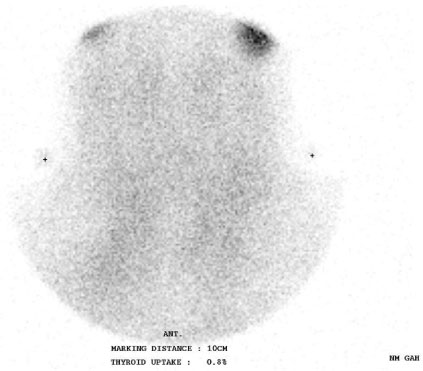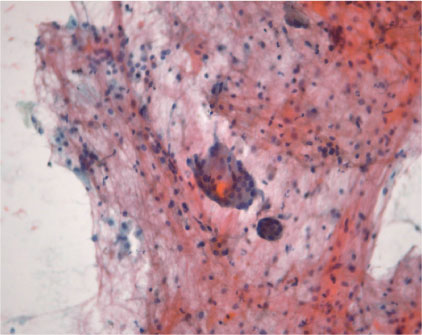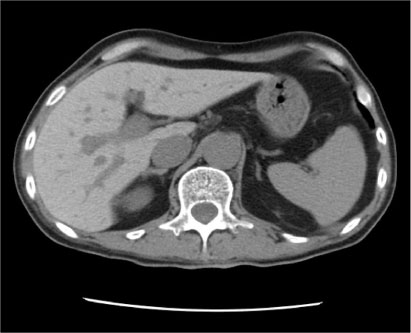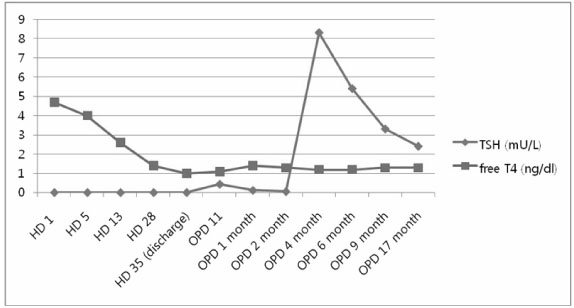J Korean Endocr Soc.
2007 Jun;22(3):229-234. 10.3803/jkes.2007.22.3.229.
Amiodarone Induced Thyrotoxicosis (Type II)
- Affiliations
-
- 1Department of Internal Medicine, University of Ulsan, Gangneung Asan Hospital, Korea.
- 2Department of Diagnostic Radiology, University of Ulsan, Gangneung Asan Hospital, Korea.
- 3Department of Pathology, University of Ulsan, Gangneung Asan Hospital, Korea.
- KMID: 1512037
- DOI: http://doi.org/10.3803/jkes.2007.22.3.229
Abstract
- Amiodarone is an iodinated benzofuran derivative, that is highly effective as an agent for the treatment of various cardiac arrhythmias; these arrthymias, range from paroxysmal atrial fibrillation to life-threatening ventricular tachyarrhythmias. Yet amiodarone is associated with several side effects that include dysfunction of liver, thyroid or various other organs. Two main forms of amiodarone induced thyrotoxicosis (AIT) have been described; type I AIT develops in an abnormal thyroid gland (nodular goiter, latent Graves' disease) and it is due to amiodarone-induced true hyperthyroidism; type II AIT occurs in an apparently normal thyroid gland and it is due to amiodarone-induced destructive thyroiditis. We recently experienced a case of type II thyrotoxicosis that was induced by amiodarone treatment for ventricular tachycardia after acute myocardial infarction. The symptoms of thyrotoxicosis were relieved after withdrawal of amiodarone and administering steroid. Type I AIT has often been reported on but type II AIT is relatively rare. We report here on a case of type II amiodarone induced thyrotoxicosis along with a literature review.
MeSH Terms
Figure
Reference
-
1. Lasen PR, Kronenberg HM, Melmed S, Polonsky KS. Williams Textbook of Endocrinology. 2003. 10th ed. Philadelphia: Saunders;411–412.2. DeGroot LJ, Jameson JL. Endocrinology. 2006. 5th ed. Philadelphia: Elsevier Saunders;2048–2049.3. Chinnadorai R, Rhidian FS, Stephen GG. Management of amiodarone-induced thyrotoxicosis. Swiss Med Wkly. 2003. 133:579–585.4. Daniels GH. Clinical Review 120: Amiodarone induced thyrotoxicosis. J Clin Endoclinol Metab. 2001. 86:3–8.5. Podrid PJ. Amiodarone: re-evaluation of an old drug. Ann Intern Med. 1995. 122:689–700.6. Vorperian VR, Havighurst TC, Miller S, January CT. Adverse effect of low dose amiodarone: a meta-analysis. J Am Coll Cardiol. 1997. 30:791–798.7. Martino E, Aghini-Lombardi F, Lippi F, Baschieri L, Safran M, Lewis E. Twenty-four hour radioactive iodine uptake in 35 patients with amiodarone associated thyrotoxicosis. J Nucl Med. 1985. 26:1402–1407.8. Harjai KJ, Licata AA. Amiodarone induced hyperthyroidism: a case series and brief review of literature. Pacing Clin Electrophysiol. 1996. 19:1548–1554.9. Newman CM, Price A, Davies DW, Gray TA, Weetman AP. Amiodarone and the thyroid: a practical guide to the management of thyroid dysfunction induced by amiodarone therapy. Heart. 1998. 79:121–127.10. Saad A, Falciglia M, Steward DL, Nikiforov YE. Amiodarone-induced thyrotoxicosis and thyroid cancer; Clinical, immunohistorical, and molecular genetic studies of a case and review of the literature. Arch Pathol Lab Med. 2004. 128:807–810.11. Meurisse M, Gollogly L, Degauque C, Fumal I, Defechereux T, Hamoir E. Iatrogenic thyrotoxicosis: causal circumstances, pathophysiology, and principles of treatmentreview of the literature. World J Surg. 2000. 24:1377–1385.12. Brennan MD, Erickson DZ, Carney JA. Non-goitrous (type I) amiodarone-associated thyrotoxicosis - Evidence of follicular disruption in-vitro and in-vivo. Thyroid. 1995. 5:177–183.13. Bartalena L, Grasso L, Brogioni S, Aghini-Lombardi F, Braverman LE, Martino E. Serum interleukin-6 in amiodarone-induced thyrotoxicosis. J Clin Endocrinol Metab. 1994. 78:423–427.14. Leger AF, Massin JP, Laurent MF, Vincens M, Auriol M, Helal OB, Chomette G, Savoie JC. Iodine induced thyrotoxicosis: analysis of eighty-five consecutive cases. Eur J Clin Invest. 1984. 14:449–455.15. Bartalena L, Bogazi F, Martino E. Amiodarone-induced thyrotoxicosis: a difficult diagnostic and therapeutic challenge. Clin Endocrinol. 2002. 56:23–24.16. Moolman JA. Thyroid hormone and the heart. Cardiovasc J S Afr. 2002. 13:159–163.17. Bogazzi F, Bartalena L, Brogioni S, Maxxeo S, Vitti P, Burelli A. Colour flow doppler sonography rapidly different iates type I and type II amiodarone-induced thyrotoxicosis. Thyroid. 1997. 7:541–545.18. Wolff J. Perchlolate and the thyroid gland. Pharmacol Rev. 1998. 50:89–105.19. Gustavo AC, JOS MC, Camilo AL. Amiodarone-induced thyrotoxicosis: Diagnostic and therapeutic strategies. Cleve Clin J Med. 2003. 70:624–626. 628–631.20. Martino E, Bartalena L, Bogazzi F, Braverman LE. The effects of amiodarone on the thyroid. Endocr Rev. 2001. 22:240–254.






